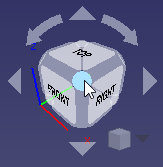Cubo de Navegação
O controle do cubo de navegação, ou 'cubo de navegação, é uma ajuda gráfica de interface com o usuário para reorientar a visualização 3D. Por padrão, ele é visível e reside no canto superior direito da tela 3D. Se você estiver olhando para a vista 3D padrão, ela se parece com o seguinte:
O cubo de navegação é composto de várias partes:
- Setas direcionais
- Cubo de navegação principal
- Menu mini-cubo
Hovering the mouse pointer over a feature of the navigational cube turns the feature light blue; clicking will reorient the 3D view as indicated by the feature. In the example below, the 3D view has been rotated by a mouse gesture to a "non-standard" orientation. The pointer is over a corner (indicated by the blue color); clicking will reorient the 3D view to a standard axonometric view with that corner facing you.
Setas direcionais =
Há seis setas direcionais: quatro setas triangulares, na parte superior, inferior, esquerda e direita; e duas setas curvas, uma de cada lado da seta superior.
Clicando nas setas triangulares, a vista 3D girará 45 graus em torno de uma linha perpendicular à direção da seta. Clicando nas setas curvas, a vista 3D será girada em torno de uma linha que aponta na sua direção.
The main navigation cube ("nav cube" in the rest of this section), tracks the orientation of the actual object in the main part of the 3D view. Any operation which reorients the main 3D view will reorient the nav cube as well.
The nav cube is essentially a 3D view of a cube with its three main component types (faces, edges, and corners) enhanced so they may be easily clicked with the pointer. Clicking on a particular component will set the 3D view to have that component centered and facing you. The nav cube is somewhat "squashed", as if the feature farthest from you were larger than the feature directly facing you. This allows the features adjacent to the feature facing you to be seen and consequently selected. For example, in a "normal" view of a regular cube, when one face is facing you, you can also see the four edges of that face and the four corners of that face. In the "squashed" nav cube, you can also see features representing each of the adjacent faces, the four edges connecting the corners of the face facing you with the opposite face, and the corners of opposite face. This allows you to select any of the possible standard views except the opposite face and its edges (21 out of 26 possible views):
- The face facing you (does nothing, since that is the current view)
- The four edges of the current face
- The four corners of the current face
- The four adjacent faces
- The four edges leading to the opposite face
- The four corners of the opposite face
Not possible:
- The opposite face
- The edges of the opposite face
Note: As of this writing (v 0.18), there are some problems with the nav cube; not all features are currently selectable. In particular, edges are not selectable, nor are the four corners of the immediately facing face.
Face Selection
Clicking on a face will orient the 3D view with that particular face facing you. From a face view, other selection points are available as noted above. There are four thin "bars" on each of the outside edges, representing the four adjacent faces; clicking them will select the view corresponding to the adjacent face. There are four round corners which may be used to set the corresponding axonometric view. There is also an interior set of edges and corners, which are currently non-functional.
Seleção de bordas
Infelizmente, a seleção de bordas está atualmente quebrada. A tentativa de selecionar uma borda selecionará a face por trás dela. Ao clicar em uma borda, você deve centralizá-la de modo que ela esteja de frente para você.
Seleção de cantos
Clicando em um dos cantos você terá uma visão axonométrica a partir daquele canto. Como mencionado acima, atualmente, quando um rosto está diretamente voltado para você, os cantos desse rosto não podem ser selecionados.
Menu mini-cubo
No canto inferior direito do cubo de navegação está um pequeno cubo. Clicando neste cubo, aparecerá um menu que você pode usar para mudar o tipo de vista (Ortográfica, Perspectiva, Isométrica) e para "Zoom to Fit".
Você pode mover toda a estrutura de controle do cubo de navegação para outro local na tela 3D, pressionando o mouse em qualquer lugar no cubo de navegação principal e arrastando. A estrutura não começará a se mover até que o ponteiro do mouse tenha passado a borda do cubo de navegação principal.
Configuração
O cubo de navegação é configurável, incluindo o ajuste de seu tamanho: Editar → Preferências... → Tela → Navegação → Cubo de Navegação introduced in version 0.19.
Para uma configuração mais avançada, consulte o CubeMenu Bancadas de trabalho externas.
- Getting started
- Installation: Download, Windows, Linux, Mac, Additional components, Docker, AppImage, Ubuntu Snap
- Basics: About FreeCAD, Interface, Mouse navigation, Selection methods, Object name, Preferences, Workbenches, Document structure, Properties, Help FreeCAD, Donate
- Help: Tutorials, Video tutorials
- Workbenches: Std Base, Arch, Assembly, CAM, Draft, FEM, Inspection, Mesh, OpenSCAD, Part, PartDesign, Points, Reverse Engineering, Robot, Sketcher, Spreadsheet, Surface, TechDraw, Test Framework
- Hubs: User hub, Power users hub, Developer hub

